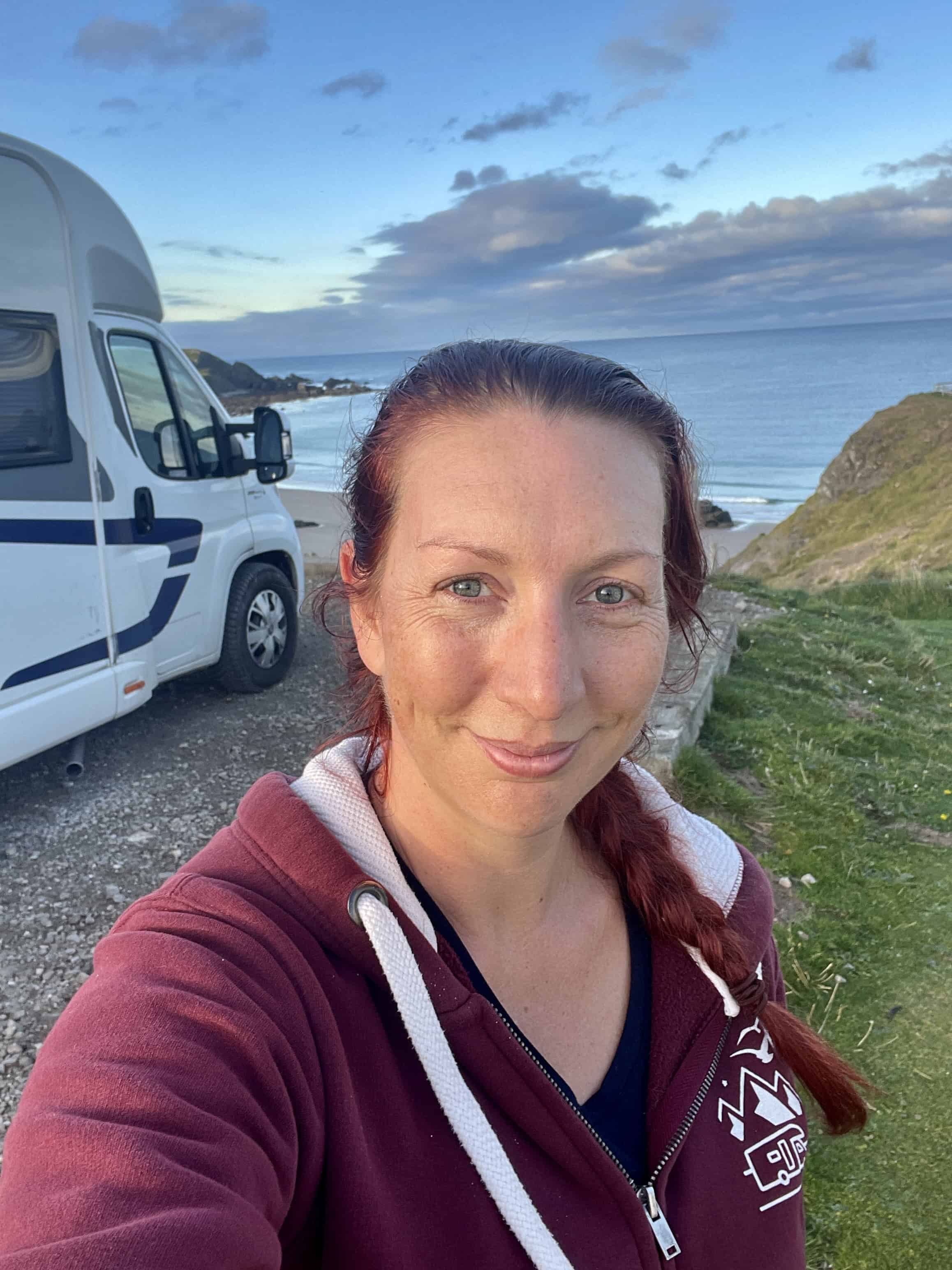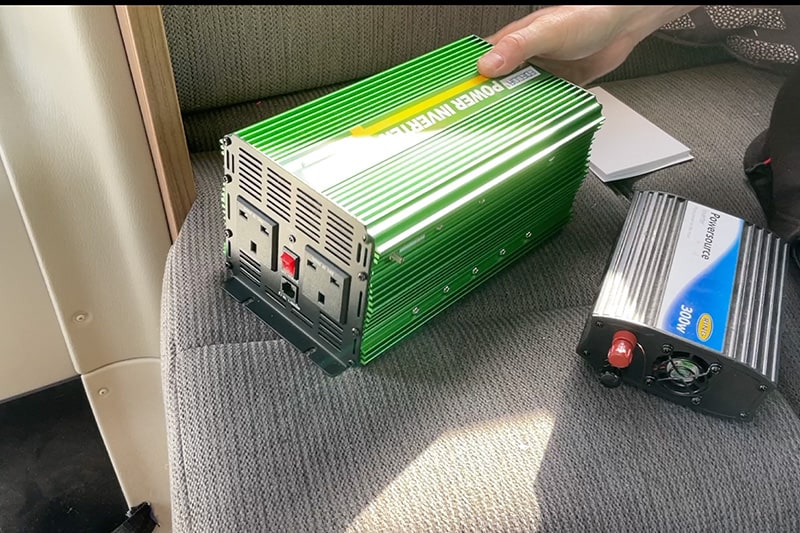Considering an inverter for your motorhome or campervan? Not sure what size you need or which is best? Don’t worry- here’s everything you need to know about choosing the best motorhome inverter for you.
Don’t forget to grab your FREE motorhome maintenance checklist below
*We work hard to make this the best motorhome blog and road trip website possible, full of helpful content for you. The website is supported by our readers, so if you buy through links on this site we may earn a commission- at no extra cost to you. All opinions remain our own.
If you find this post useful, you can also treat us to a coffee at the bottom of this page- we promise to enjoy it while creating more useful content like this- we might even indulge in a biscuit (or two!)
Motorhome inverters- the basics
I’ll be honest, I don’t really ‘get’ electrics. And I definitely don’t get anything which involves playing around with motorhome power systems and batteries which can kill me if (when!) I get it wrong.
Still, ever since our very first motorhome, we’ve agreed an inverter is an essential piece of kit for the way we use the van, so, when my last one broke (my fault!), I needed to get a new one.
So, the first question is: why?
Do you need an inverter?
Most people who use campsites regularly probably don’t need to bother about fitting an inverter in their motorhome or camper. After all, the idea of it is to change 12v power from the leisure battery into 230v power which can be used to power appliances like laptops and hairdryers.
So, if you already mainly use campsites and their power supply, you can already power/ recharge these devices.
However, we LOVE motorhome wild camping/ parkups. We like staying off-grid, or using aires in France, or staying in forestry car parks.
None of these have power available, so we need to be self-sufficient. Whilst the motorhome can survive for several days off-grid, devices like my laptop (which this entire motorhome blog was built on) or our drone, or our Ecoflow power station, all need topping up in order for us to continue to spend time off-grid.
We also tour with motorbikes, and often use the inverter to recharge our helmet intercoms or our heated clothing battery packs.
For that reason, for us, it’s a van life essential and allows us to be much more flexible rather than needing campsites all the time. (See more motorhoming essentials here.)
What size inverter do you need in a motorhome or campervan?
Ahhhh, isn’t that the important question!
Unlike diesel engines, you don’t want to work an inverter hard. You actually want there to be some wiggle room.
Great, so just buy the biggest one the market?
Nope- coz that’s a)- expensive and b)- will drain your leisure battery super fast. There needs to be a bit more thought into what size inverter you need to fit.
Inverters are not 100% efficient. In fact, for most inverters, you can expect about 80-85% efficiency. Therefore, to know the size you need, take the largest appliance you want to power from the inverter, see what it draws (input power), then make sure you add at least 20%- that’s the size inverter you need.
There are two types of power you’ll see on an inverter- continuous power output and peak power output.
Peak power is short-duration, usually on start-up. Continuous is… continuous. This is the number you need to look at when you’re picking one to purchase.
My first inverter was 300w. As you can see in the video, it wasn’t big enough to do what I needed it to do. The new one is 2000w!
This is the one we just fitted:

Pure sine or modified sine?
Ok, if you understand electrics look away now, because this is probably more basic then you want it to be.
A pure sine wave gives a smooth voltage curve, which is what most appliances are designed to run on. A modified sine wave has ‘steps’ where the power increases or decreases in jumps. These jumps in voltage can cause problems with delicate electrics, like laptops, TVs, coffee makers, power stations and CPAP machines. It can also cause overheating of transformers and chargers.
However, they’re often fine to power things like hairdryers, power drills, battery packs etc.
Because they’re not as refined, modified sine wave inverters are MUCH cheaper to buy than pure sine.
NOTE: If you’re buying off Amazon or online, many overseas places state their device is pure-sine when it’s not. Do your research carefully. You can see the one we got in the Youtube link above.
Fitting an inverter in a motorhome
Here’s how we fitted our new inverter in our motorhome. It wasn’t too difficult BUT, if you’re in any way unsure, please ask a professional to help so you don’t hurt yourself or damage your systems.
Tips for fitting a motorhome inverter
Here are some tips to help you:
- Don’t let anything touch the battery terminals together
- Inverters are the most current-heavy items you can attach to a 12V battery. Use lots of fuses as safety breakers.
- Modern battery cables have the continuous current rating marked on them – make sure your fuse never exceeds these rating.
- Make sure the wires/ leads are the correct gauge. Some inverters are supplied with cheaper leads which aren’t strong enough to do the job.
- Some small inverters can be powered from a 12V cigarette socket. DON’T plug thes into the socket in the cab as that is powered by your vehicle battery and will drain it. Only use it from sockets in the hab area which are powered from your leisure battery.
- Bear in mind that just because it can be powered by a cigarette lighter, doesn’t mean the cigarette lighter in your van is strong enough to power it; a 120W inverter can draw around 10A, which will likely blow a cigarette-lighter fuse at full power.
- Try to place the inverter as close to the leisure battery as possible to keep the cables short (max 2m for any inverter over 2000w). This reduces the temperature and voltage drop in the cables.
- If this is not possible, increase the diameter of the cables.
How to use a motorhome inverter
The easiest way to use a motorhome inverter is to plug your device or appliance straight into the 230v 3-pin plug socket actually on the inverter.
Alternatively, you can use an extension lead to make it easier to access, but don’t overload the inverter with too much.
It’s really complicated to get an inverter to run the existing 3-pin sockets in the habitation area of your motorhome, so try to avoid thinking of it like that.
We ONLY use our inverter whilst we’re driving. This allows us to charge devices ready for use when we stop AND stops us from accidentally draining the leisure battery. We also never use it for longer than an hour and it’s rarely running at anything close to full power.
How long will an inverter run off a motorhome battery?
Like everything else, this will depend on the size of the inverter, the size of your motorhome leisure battery/ batteries and the size of the device(s) you are powering.
However, to give you an idea, a 2000w inverter (like the one we installed), running at FULL POWER (which is unlikely for a long period), could flatten a 100A motorhome leisure battery in 36 minutes.
Here’s the maths:
- 2000w/ 12v= 166.6 amps/ hour
- 100amp battery/ 166.6= 0.6 hours (36 minutes)
BUT- you don’t want to flatten your battery, so in reality you only have about 18 minutes of full-power use before you need to stop. This is another reason we only use the inverter whilst driving AND only after we’ve been driving a while, so the battery has had time to get at least a little bit recharged.
In the way WE use the motorhome, an inverter is essential. But it’s not for everyone. Before you lay out on one, make sure you think it’s something you’ll definitely need.
Want more tips for motorhome life?
Here are some more ideas you might find useful:
Want FREE checklists, eBooks and additional tips to help? Visit our resource page



